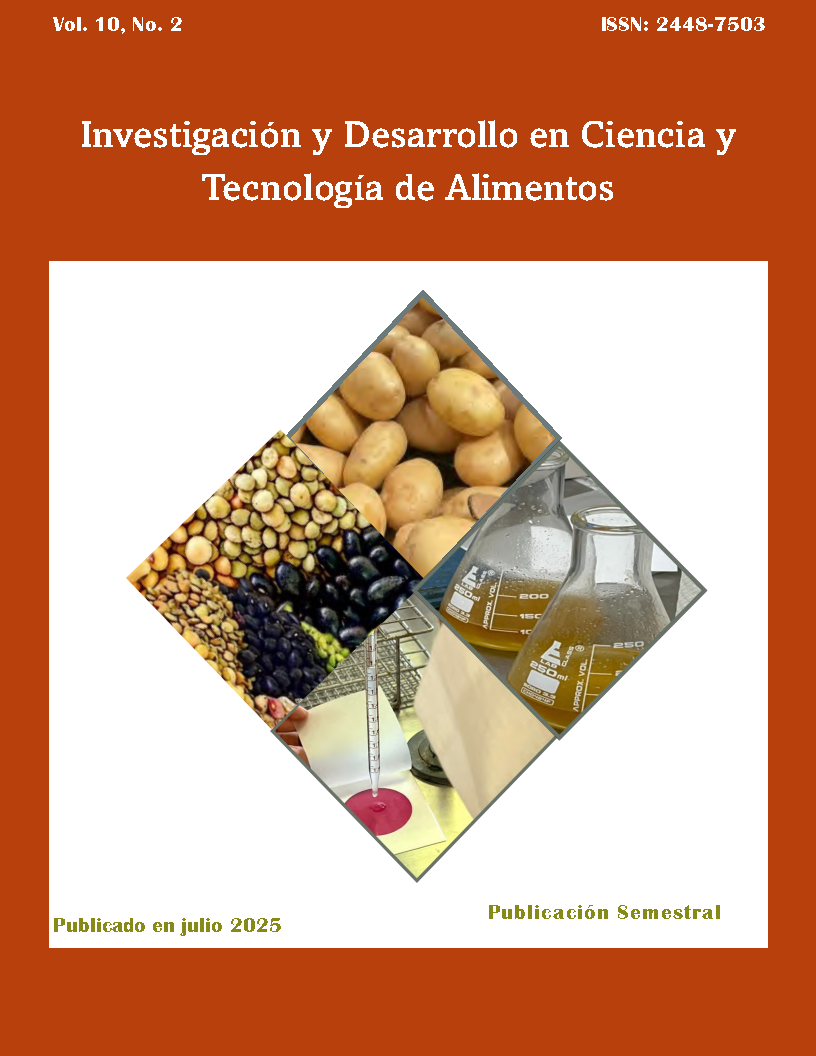Changes in nutritional and bioactive value in green prickly pear due to hot air drying
DOI:
https://doi.org/10.29105/idcyta.v10i2.137Keywords:
deshidratación, ácido ascórbico, tuna, fitoquímicosAbstract
The prickly pear is a representative fruit of Mexico. It is considered a very healthy fruit because of its high wáter content, fiber, vitamins and minerals content. Its flavor, freshness and different varieties make it very attractive to the consumer. Hot air drying is a dehydration technique that stands out from other methods due to its simplicity, short processing times and the fact that it does not depend on climatic variations. This dehydration technique could be considered as an alternative for the transformation, conservation and commercial use of prickly pear. Therefore, the objective of this study was to determine the effect of hot air drying at different temperatures (40, 50, 60 and 70°C) on the nutritional and bioactive value of prickly pear. Samples were analyzed fresh as well as after the dehydration process for vitamin C content, total polyphenols, and antioxidant capacity. Statistically significant differences in vitamin C content, total polyphenols and antioxidant capacity were observed between drying temperatures. Drying caused a decrease in the initial vitamin C content value of the dehydrated simples at 40 and 70 °C. In total phenols, the greatest reduction was 16% in samples dehydrated at 40°C. Finally, an increase on the antioxidant capacity was observed in the dehydrated samples, regardless of the analysis method used.
Downloads
References
Adeyeye S.A.O., T. J. Ashaolu & A. S. Babu (2022). Food Drying: A Review. Agricultural Reviews. DOI: 10.18805/ag.R-2537. DOI: https://doi.org/10.18805/ag.R-2537
Ammar I., M. Ennouri, O. Bali, H. Attia (2014). Characterization of two prickly pear species flowers growing in Tunisia at four flowering stages. LWT- Food Science and Technology 59: 448e454. http://dx.doi.org/10.1016/j.lwt.2014.05.002 DOI: https://doi.org/10.1016/j.lwt.2014.05.002
AOAC, Association of Official Analytical Chemists (2000) Official Methods of Analysis of AOAC international (17th ed.). Association of Official Analytical Chemists. Gaithersburg, Maryland, USA. 2200 p.
Boutakiouta A., D. Elothmani, H. Hanine, M. Mahrouz, D. Le Meurlay, I. Hmidb & S. Ennahli (2018). Effects of different harvesting seasons on antioxidant activity and phenolic content of prickly pear cladode juice. Journal of the Saudi Society of Agricultural Sciences. 17: 471–480 DOI: https://doi.org/10.1016/j.jssas.2016.11.005
Brand-Williams W., M. E. Cuvelier and C. Berset (1995) Use of free radical method to evaluate antioxidant activity. LWT - Food science and technology 28:25-30, https://doi.org/10.1016/S0023-6438(95)80008-5 DOI: https://doi.org/10.1016/S0023-6438(95)80008-5
Caban, M. y Lewandowska U. (2022). Polyphenols and the potential mechanisms of their therapeutic benefits against inflammatory bowel diseases. Journal of Functional Foods. 95: 105181 DOI: https://doi.org/10.1016/j.jff.2022.105181
Domínguez-García I. A., M. R. Granados-Sánchez, L. M. Sagarnaga-Villegas, J. M. Salas-González y J. Aguilar-Ávila. (2017) Viabilidad económica y financiera de nopal tuna (Opuntia ficus-indica) en Nopaltepec, Estado de México. Revista Mexicana de Ciencias Agrícolas. Vol.8, Núm. 6, p. 1371-1382 DOI: https://doi.org/10.29312/remexca.v8i6.304
García-Curiel L., J.G. Pérez-Flores, F. Mera-Reyes, D. Esparza-Vital, E. Pérez-Escalante, E. Contreras-López, C. Ángel-Jijón y E. J. Olloqui (2024). Potencial nutricional y terapéutico de la tuna y de sus subproductos: un panorama general de su composición química y aplicaciones. Facultad de Ciencias Biológicas UANL.Vol. 7 No. 14, segundo semestre 2024 DOI: https://doi.org/10.29105/bys7.14-126
Gatea, A.A. (2011). Design and construction of a solar drying system,a cylindrical section and an analysis of the performance of the thermal drying system. African Journal of Agricultural Research. 6: 343-351.
Goncalves Albuquerque T., P. Pereira, M. A. Silva, F. Vicente, R. Ramalho and H. S. Costa (2020). Nutritional Composition and Antioxidant Properties of Fruits and Vegetables. Chapter 44. Prickly Pear. Vol. II: 709-728 DOI: https://doi.org/10.1016/B978-0-12-812780-3.00044-1
Li B. B., B. Smith and M. M. Hossain (2006) Extraction of phenolics from citrus peels: II. Enzyme-assisted extraction method. Separation and purification technology 48:189-196, https://doi.org/10.1016/j.seppur.2005.07.019 DOI: https://doi.org/10.1016/j.seppur.2005.07.019
Re R., N. Pellegrini, A. Proteggente, A. Pannala, M. Yang and C. Rice-Evans (1999) Antioxidant activity applying an improved ABTS radical cation decolorization assay. Free radical biology and medicine 26:1231-1237, https://doi.org/10.1016/S0891-5849(98)00315-3 DOI: https://doi.org/10.1016/S0891-5849(98)00315-3
Terán, Y.; Navas D.; Petit D.; Garrido E.; D’Aubeterre R. (2015). Análisis de las características físico--químicas del fruto de Opuntia ficus-Indica(l.) Miller, cosechados en Lara, Venezuela. Revista Iberoamericana de Tecnología Postcosecha. Vol. 16, núm. 1, pp. 69-74
Tomás-Barberán F. T., M. I. Gil, P. Cremin, A. L. Waterhouse, B. Hess-Pierce and A. A. Kader (2001) HPLC-DAD-ESIMS analysis of phenolic compounds in nectarines, peaches, and plums. Journal of agricultural and food chemistry 49:4748-4760, https://doi.org/10.1021/jf0104681 DOI: https://doi.org/10.1021/jf0104681
WHO, 2020. World Health Organization (April, 20, 2024). Increasing fruit and vegetable consumption to reduce the risk of noncommunicable diseases. https://www.who.int/tools/elena/interventions/fruit-vegetables-ncds.
Zhou Y., L. Hu, Y. Chen, L. Liao, R. Li, H. Wang, Y. Mo, L. Lin & K. Liu (2022). The combined effect of ascorbic acid and chitosan coating on postharvest quality and cell wall metabolism of papaya fruits. LWT- Food Science and Technology. 171: 114134 DOI: https://doi.org/10.1016/j.lwt.2022.114134
Downloads
Published
How to Cite
Issue
Section
License
Copyright (c) 2025 Cristina Sarai Contreras Martínez, Aida Margarita Rodríguez Rodríguez, Laura Gisela Ramos Muñoz, José Carranza Téllez, Juan Manuel García González, JOSE CARRANZA CONCHA

This work is licensed under a Creative Commons Attribution 4.0 International License.
Los autores/as que publiquen en esta revista aceptan las siguientes condiciones:
a. Los autores/as conservarán sus derechos de autor y garantizarán a la revista el derecho de primera publicación de su obra, el cual estará simultáneamente sujeto a la Licencia Creative Commons Atribución 4.0 Internacional. que permite a terceros compartir la obra siempre que se indique su autor y su primera publicación esta revista.
b. Los autores/as pueden realizar otros acuerdos contractuales independientes y adicionales para la distribución no exclusiva de la versión del artículo publicado en esta revista (p. ej., incluirlo en un repositorio institucional o publicarlo en un libro) siempre que indiquen claramente que el trabajo se publicó por primera vez en esta revista.
c. Se permite y recomienda a los autores/as a publicar su trabajo en Internet (por ejemplo en páginas institucionales o personales) posterior al proceso de revisión y publicación, ya que puede conducir a intercambios productivos y a una mayor y más rápida difusión del trabajo publicado.





